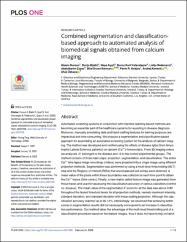| dc.contributor.author | Dursun, Gizem | |
| dc.contributor.author | Bijelić, Dunja | |
| dc.contributor.author | Ayşit, Neşe | |
| dc.contributor.author | Kurt Vatandaşlar, Burcu | |
| dc.contributor.author | Radenović, Lidija | |
| dc.contributor.author | Çapar, Abdulkerim | |
| dc.contributor.author | Kerman, Bilal Ersen | |
| dc.contributor.author | Andjus, Pavle R. | |
| dc.contributor.author | Korenić, Andrej | |
| dc.contributor.author | Özkaya, Ufuk | |
| dc.date.accessioned | 2023-02-20T09:03:57Z | |
| dc.date.available | 2023-02-20T09:03:57Z | |
| dc.date.issued | 2023 | en_US |
| dc.identifier.citation | Dursun, G., Bijelić, D., Ayşit, N., Kurt Vatandaşlar, B., Radenović, L. ve Çapar, A. (2023). Combined segmentation and classificationbased approach to automated analysis of biomedical signals obtained from calcium imaging. PLoS One, 18(2). https://doi.org/10.1371/journal.pone.0281236 | en_US |
| dc.identifier.issn | 1932-6203 | |
| dc.identifier.uri | https://doi.org/10.1371/journal.pone.0281236 | |
| dc.identifier.uri | https://hdl.handle.net/20.500.12511/10484 | |
| dc.description.abstract | Automated screening systems in conjunction with machine learning-based methods are becoming an essential part of the healthcare systems for assisting in disease diagnosis. Moreover, manually annotating data and hand-crafting features for training purposes are impractical and time-consuming. We propose a segmentation and classification-based approach for assembling an automated screening system for the analysis of calcium imaging. The method was developed and verified using the effects of disease IgGs (from Amyotrophic Lateral Sclerosis patients) on calcium (Ca2+) homeostasis. From 33 imaging videos we analyzed, 21 belonged to the disease and 12 to the control experimental groups. The method consists of three main steps: projection, segmentation, and classification. The entire Ca2+ time-lapse image recordings (videos) were projected into a single image using different projection methods. Segmentation was performed by using a multi-level thresholding (MLT) step and the Regions of Interest (ROIs) that encompassed cell somas were detected. A mean value of the pixels within these boundaries was collected at each time point to obtain the Ca2+ traces (time-series). Finally, a new matrix called feature image was generated from those traces and used for assessing the classification accuracy of various classifiers (control vs. disease). The mean value of the segmentation F-score for all the data was above 0.80 throughout the tested threshold levels for all projection methods, namely maximum intensity, standard deviation, and standard deviation with linear scaling projection. Although the classification accuracy reached up to 90.14%, interestingly, we observed that achieving better scores in segmentation results did not necessarily correspond to an increase in classification performance. Our method takes the advantage of the multi-level thresholding and of a classification procedure based on the feature images, thus it does not have to rely on hand- crafted training parameters of each event. It thus provides a semi-autonomous tool for assessing segmentation parameters which allows for the best classification accuracy. | en_US |
| dc.language.iso | eng | en_US |
| dc.publisher | Public Library of Science | en_US |
| dc.rights | info:eu-repo/semantics/openAccess | en_US |
| dc.subject | Biomedical Signals | en_US |
| dc.subject | Calcium Imaging | en_US |
| dc.subject | Combined Segmentation | en_US |
| dc.title | Combined segmentation and classificationbased approach to automated analysis of biomedical signals obtained from calcium imaging | en_US |
| dc.type | article | en_US |
| dc.relation.ispartof | PLoS One | en_US |
| dc.department | İstanbul Medipol Üniversitesi, Rektörlük, Rejeneratif ve Restoratif Tıp Araştırmaları Merkezi (REMER) | en_US |
| dc.department | İstanbul Medipol Üniversitesi, Rektörlük, Sağlık Bilim ve Teknolojileri Araştırma Enstitüsü | en_US |
| dc.department | İstanbul Medipol Üniversitesi, Tıp Fakültesi, Temel Tıp Bilimleri Bölümü, Histoloji ve Embriyoloji Ana Bilim Dalı | en_US |
| dc.authorid | 0000-0003-1106-3288 | en_US |
| dc.identifier.volume | 18 | en_US |
| dc.identifier.issue | 2 | en_US |
| dc.relation.publicationcategory | Makale - Uluslararası Hakemli Dergi - Kurum Öğretim Elemanı | en_US |
| dc.identifier.doi | 10.1371/journal.pone.0281236 | en_US |
| dc.institutionauthor | Ayşit, Neşe | |
| dc.institutionauthor | Kurt Vatandaşlar, Burcu | |
| dc.institutionauthor | Kerman, Bilal Ersen | |
| dc.identifier.wosquality | Q2 | en_US |
| dc.identifier.wos | 000966740700001 | en_US |
| dc.identifier.scopus | 2-s2.0-85147536496 | en_US |
| dc.identifier.pmid | 36745648 | en_US |
| dc.identifier.scopusquality | Q1 | en_US |


















